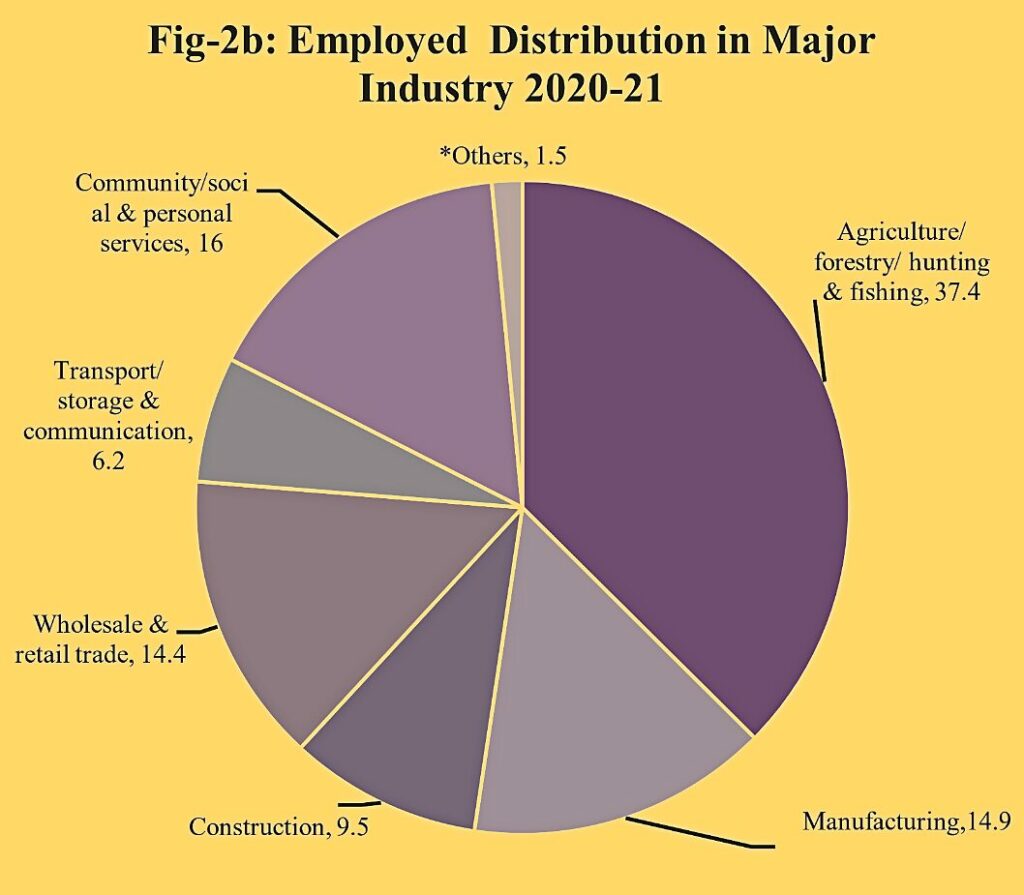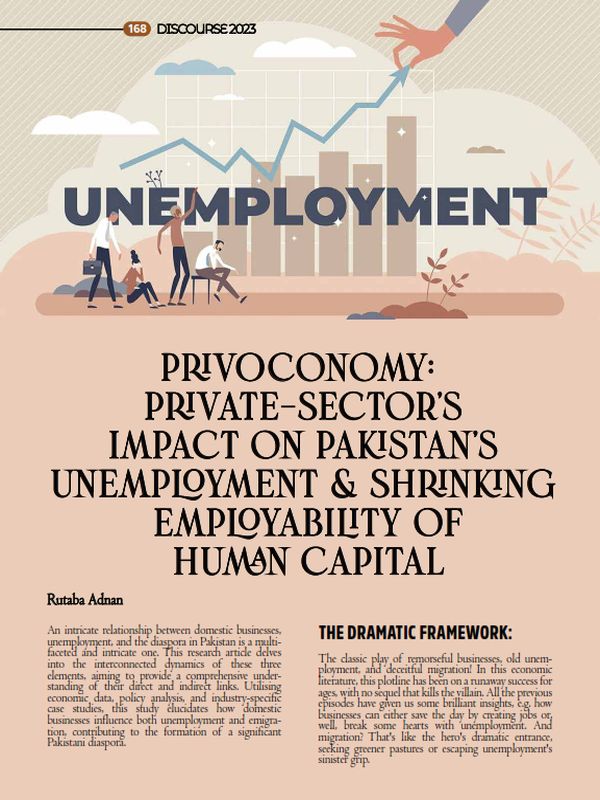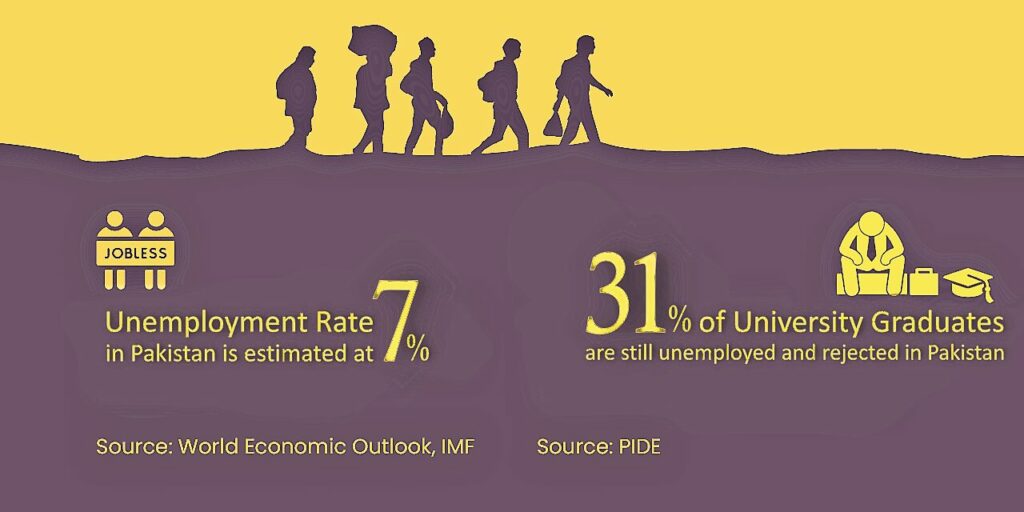Privoconomy: Private-Sector’s Impact on Pakistan’s Unemployment & Shrinking Employability of Human Capital
An intricate relationship between domestic businesses, unemployment, and the diaspora in Pakistan is a multifaceted and intricate one. This research article delves into the interconnected dynamics of these three elements, aiming to provide a comprehensive understanding of their direct and indirect links. Utilising economic data, policy analysis, and industry-specific case studies, this study elucidates how domestic businesses influence both unemployment and emigration, contributing to the formation of a significant Pakistani diaspora.
The Dramatic Framework:
The classic play of remorseful businesses, old unemployment, and deceitful migration! In this economic literature, this plotline has been on a runaway success for ages, with no sequel that kills the villain. All the previous episodes have given us some brilliant insights, e.g. how businesses can either save the day by creating jobs or, well, break some hearts with unemployment. And migration? That’s like the hero’s dramatic entrance, seeking greener pastures or escaping unemployment’s sinister grip.
But, wait, we’re in Pakistan, fellows, and this isn’t your typical fictional tale. Our economic and social backdrop is more complicated than a Shakespearean drama. With the history packed with twists and turns, political turmoil, and dysfunctional global relationships, this non-fiction uncovers the role of private sector in the face of unemployed skill in Pakistan. In previous decades, the private sector played a significant role in job creation domestically. However, during times of economic distress or crises, private sector companies had to cut back on hiring and even laid off workers to reduce costs, which contributed to rising unemployment. The impact of political distress and economic shocks, such as the COVID-19 crisis and macroeconomic turmoil, adversely affected the private sector’s ability to create jobs. When businesses were struggling, they were hesitant to hire new employees, leading to job losses or stagnant employment levels.
The chart below by the World Bank labels the unemployment in Pakistan that’s been further bruised over two decades using modeled estimate of ILO:
Unemployment Rate – ILO Estimated Model 2022
Pakistan faces the twin challenges of high unemployment rates and significant emigration, resulting in a large Pakistani diaspora worldwide. The burden however doesn’t stand still on the private sector since the government must empower the business community to prioritise productivity-driven initiatives to begin with. By forcing a 3.5% GDP growth rate upon itself, the government has committed to higher public consumption expenses rather than incentivising the private sector to take up the mantle of investment that could spur GDP growth and create employment opportunities. This article explores the often-overlooked link between domestic businesses and these issues. It aims to answer the question: is there a direct link between domestic businesses, rising unemployment and growth in the Pakistani diaspora?
This study utilises a comprehensive analysis of economic data, government reports, and industry-specific examples. Limitations include potential data gaps and the complexity of causal relationships.
With a whimsical deployment of Artificial Intelligence in the workplace, human capital is the most vital component not only for a company, but also for economic development. Managing this resource effectively can boost economic performance and reduce social distress. Pakistan is the fifth most populous nation globally, with a population of 224.78 million in 2022. Boasting one of the world’s largest labour forces, ranking among the top 10 globally, Pakistan still struggles with channeling sufficient employment opportunities for this vast workforce.
Labour Force & Employment Indicators (people count in million)
The above labour force statistics for Pakistan reveals a mixed picture of employment dynamics. On one hand, there’s a substantial increase in the size of the labour force, which expanded from 65.5 million in 2018 to 71.76 million in 2021. Potentially driven by demographic factors, a larger labour force implies more people actively seeking employment.
On the other hand, the increase in the labour force has been met with corresponding growth in the number of employed individuals, rising from 61.71 million to 67.25 million over the same period. This growth in employment is a positive development, indicating that the economy has been able to create jobs for a portion of the expanding labour force.
A Pyramid: Private Sector, Unemployment & Diaspora
This study aims to assess whether there is a direct link between the actions of domestic businesses and unemployment. In Pakistan, the private sector employs 90 percent of the labour force, while the public sector employs only 10 percent. Small and medium enterprises, as well as agriculture, play a crucial role in providing employment opportunities. Private sector growth, particularly of smaller firms and farms, is vital for both employment generation and poverty reduction. After analysing case studies from specific industries and regions, the intricate relationship between private-sector and employment prevailed. For example, during the COVID-19 pandemic, several industries experienced layoffs, directly impacting unemployment rates.
Domestic businesses in Pakistan play a pivotal role in shaping the employment landscape. They can both create and destroy jobs. The data reveals fluctuations in employment trends across various sectors, with some industries experiencing rapid expansion while others contract. These trends are often influenced by business cycles, technological advancements, and policy decisions.
Domestic businesses in labour-intensive sectors, such as agriculture and retail, contribute significantly to employment. For instance, the agricultural sector employs a substantial portion of the population. However, capital-intensive industries, like technology and manufacturing, may not be as directly linked to high employment levels. The data shows that during economic downturns, businesses are more likely to cut jobs, which can lead to an increase in unemployment rates and further diaspora.
The diaspora presents challenges for Pakistan’s private sector, sweeping away skilled minds to distant lands in search of greener pastures abroad. This drain hampers local businesses’ access to experienced talent, impacting innovation and growth. Relying heavily on remittances can also limit domestic investment and entrepreneurial ventures, potentially hindering local economic development.
Trend in Emigration 2011-2023
The low cost of emigration makes the Middle East an attraction for unskilled labour in Pakistan

Additionally, the trend of remote engagement from the diaspora might lead to a loss of on-the-ground expertise and overseas-focused business approaches that may not fully align with the local market. Addressing these challenges requires strategies to retain local talent and foster sustainable domestic growth.
How Businesses Contribute to Unemployment and Diasporic Conditions
Pakistan’s private sector plays a pivotal role in sculpting the employment outlook, and the interaction between private businesses and unemployment is intricately influenced by a myriad interconnected factors. The causes contributing to this dynamic are multifaceted:
- Economic conditions: the cyclical nature of economic conditions, marked by periods of recession and stagnation, directly affects private sector employment. Economic downturns can lead to workforce reductions and increased unemployment.
- Technological advancements: the advent of automation and mechanisation in industries can displace human labour, resulting in job losses.
- Structural issues: a significant skills gap within the labour market often leaves businesses struggling to find workers with the required qualifications, exacerbating unemployment.
- Policy environment: labour market regulations and taxation policies have a direct impact on hiring and firing practices within the private sector. Stringent regulations can deter businesses from expanding their workforce.
- Informal economy: a substantial portion of employment in Pakistan resides in the informal sector, characterised by underemployment, instability and job insecurity. This leads to low wages and poor working conditions, contributing to financial hardship – particularly with the rising cost of living.
- Industrial composition: the dominance of specific industries, such as agriculture, retail, and small-scale manufacturing, may not generate sufficient jobs to absorb the burgeoning labour force. The following pie suggests the distribution of workforce in Pakistan across different industries.
Employed Distribution in Major Industries 2022

Source: Finance Ministry of Pakistan
- Political and social factors: political instability and social issues, including gender inequality and unequal access to education, can influence private sector investments and job creation.
- Global factors: Pakistan’s private sector is not insulated from global economic trends. Economic shocks and global downturns can have repercussions in export-oriented industries, affecting local employment.
- Investment and entrepreneurship: the presence of a robust entrepreneurial ecosystem and investments in the private sector can foster the creation of businesses and startups, thereby generating job opportunities.
- Infrastructure and access to markets: inadequate infrastructure and limited access to markets can hamper business growth and expansion, impacting employment prospects.
These multifaceted causes, intertwined within the private sector’s operations, collectively shape the employment landscape in Pakistan. Understanding this complex interplay is pivotal for crafting effective policy measures to address unemployment and foster sustainable job growth.
Obstacles to Employment by Companies
The challenges faced by domestic businesses in Pakistan in generating ample employment opportunities include:
- Economic instability: Pakistan’s economy has faced periods of instability, including inflation, currency devaluation, and high interest rates. These factors can discourage investment and hinder business growth, leading to limited job creation.
- Lack of access to finance: many domestic businesses in Pakistan struggle to access affordable financing options. Limited access to credit and high interest rates make it difficult for businesses to expand their operations and create new job opportunities.
- Skills gap: there is a significant gap between the skills possessed by the workforce and the skills required by businesses. The lack of skilled workers in specific sectors hampers the growth of industries and limits employment opportunities.
- Infrastructure challenges: inadequate infrastructure, including transportation, energy, and telecommunications, can hinder the growth of businesses. Insufficient infrastructure can increase production costs, reduce efficiency, and limit the ability of businesses to expand and create jobs.
- Regulatory burdens: complex and burdensome regulations, including licensing requirements, taxation policies, and bureaucratic red tape, can discourage entrepreneurship and hinder business growth. These regulatory challenges make it difficult for businesses to operate efficiently and create employment opportunities.
The Critical Opinion for Competent Education
In the context of unemployment in Pakistan, one crucial yet often overlooked issue is the structural limitations within the education system and its misalignment with competencies in the job market. This remains somewhat concealed beneath political discussions on job creation and economic policies. The educational system, particularly in Pakistan, is failing to equip the workforce with relevant skills needed for the job market, leading to a profound skills gap. The emphasis on theoretical knowledge over practical as meant a dearth of industry-aligned skills, thus restricting the employability of graduates. Many students leave educational institutions inadequately prepared for the demands of the rapidly evolving job landscape.
Businesses in Pakistan are more than capable of taking proactive measures that bridge this educational gap to manage unemployment effectively, but only when they choose to. To address this, a fundamental shift in the education system’s approach is imperative. Companies can collaborate closely with educational institutions to develop curriculums that align with the current and future needs of industries and promise the fostering of the market going forward.
Moreover, companies can invest in internal training programs tailored to the specific needs of their industries. As discussed above, investment in human capital development not only benefits business via a skilled workforce but also contributes to reducing the unemployment rate by making individuals more employable. Businesses should play a more active role in fostering a culture of continuous learning, offering upskilling opportunities to their employees to adapt to the rapidly evolving job market.
Politically speaking, advocating for reforms in the education system through industry consortiums and lobbying efforts is vital. By actively participating in policy discussions and reforms, businesses can influence educational policies to introduce strategic problem-solving courses in the institutions that are more likely to enhance the quality of the corporate workforce in Pakistan.
In essence, the contradiction between education and the resultant skills gap is critical. Private sector must take a more proactive role in shaping the education system to produce a skilled workforce that adds value to the business economy as whole.
Conclusion
Private-sector businesses in Pakistan are closely intertwined with both unemployment and the diaspora. While they are primary sources of job creation, they can also contribute to unemployment during economic downturns and technological shifts, thus acting as the backbone of a thriving economy. Its agility and investment potential are the key drivers of job opportunities and local business expansion. Yet, navigating this territory isn’t a walk in the park. Tackling unemployment while nurturing the growth of domestic businesses demands a synchronised effort. Governments must loosen the reins, fostering an environment conducive to entrepreneurial ventures, and break down barriers that hinder small business progress.
It’s time for policies that incentivise innovation, boost skill development, and create a synergistic relationship between private entities and regulatory frameworks Understanding the dynamics between domestic businesses, unemployment, and diaspora is not just about job creation; it’s about fostering an ecosystem where businesses can thrive and individuals can find meaningful and fulfilling work.
Wouldn’t it be incredible to propel Pakistan towards economic and fiscal success!
Citations:
- SBP Governor Ishrat Hussain. “Role of Private Sector in the Economic Development of Pakistan.” BIS Review, 8/2003, org/review/r030220d.pdf.
- Pakistan Economic Survey 2022: Population, Labour force & Employment. Government of Pakistan Finance Division, gov.pk/survey/chapter_22/PES12-POPULATION.pdf.
- Pakistan Institute of Development Economics (PIDE) Conference: Transforming the Private Sector in Pakistan I Import-Intensive Growth Model is Unsustainable?, 10/2023
- ADB Country Operations Business Plan with Country Partnership Strategy, Pakistan 2023. Asian Development Bank. 2023







